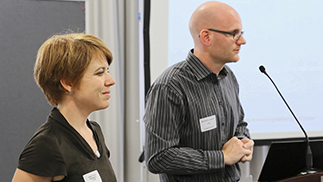Oct 7 2015
The smart living lab will build its own building to house its research and technology transfer activities in the field of sustainable architecture. Ahead of its time, this building should satisfy environmental goals set for the symbolic date of 2050.
Initial conclusions following the round table meeting of researchers and professionals on the subject of the future construction project…
 Anne-Claude Cosandey, Operational Director © Alain Herzog 2015
Anne-Claude Cosandey, Operational Director © Alain Herzog 2015
Each person living in Switzerland currently consumes an average of 6,500 watts per year. The goal for 2050 is to reduce this consumption level to almost half (3,500 watts). Likewise, each person produces about 8.6 tons of CO2 per year. The goal is to reduce this production to 2 tons per person per year. Buildings contribute a great deal to these two figures, particularly heating, which still accounts for 35% of total energy consumption.
However, with current methods and techniques, these goals cannot be reached by 2050. To build a smart living building is therefore an attempt to innovate and set an example by creating a building that can produce most, if not all, of its own energy, store it and reduce its carbon emissions. Such a building will be able to minimize its impact on the environment. Today, this ambitious goal is the subject of a research endeavor to build an environmentally friendly building by 2020. While awaiting completion of this building, the teams of the smart living lab (comprised of workers and researchers from the l'Ecole Polytechnique Fédérale de Lausanne (EPFL), the School of Engineering and Architecture of Fribourg (HEIA-FR) and the University of Fribourg (UNIFR)) will temporarily work in the Blue Hall of the blueFACTORY in Fribourg.
Field experts and researchers exchange views
Developers, builders, engineers and architects were all invited last Friday, 2 October, to exchange views on research on the smart living building. Three round table sessions were held in sequence to address key issues surrounding the development of such an avant-garde project. The various issues included such things as specifications, obstacles to innovation and building flexibility.
For the most part, speakers and participants (100 field experts) were practitioners in their field.
Flexible or rigid specifications?
What came out of discussions was that the specifications for the smart living building had to be flexible and evolve as the project progresses. This would constitute a fundamental departure from current practices since specifications are normally very precise and fixed in time. At the same time, a pluridisciplinary team (including for example sociologists and legal experts) could take part in the process of adapting specifications as the project outlines become more precise.
André Schneider, EPFL Vice-President and head of Resources and Infrastructures, confirms: “This project will enable us to build bridges between the world of construction, which tends to be rather conservative, and planners who seek to develop an innovative and multi-purpose building without overshooting the established budgetary framework.”
Legislation and standards, an obstacle to innovation?
From this round table discussion, adversity to risk-taking seemed to be a greater obstacle than the legislative framework. Who is willing to offer guarantees for innovative approaches that may or may not achieve ambitious performance targets? Construction law could also be amended over time to provide greater incentives for innovation and risk-taking (e.g. introducing measures favoring new experimental approaches). Professor Jean-Baptiste Zufferey, Director of the Institute for Swiss and International Construction Law at the University of Fribourg stated the following: “Today, this is not possible. However, the legal framework is made to be rewritten, especially if there is popular will for it.”
Building flexibility: myth or reality?
The future occupants of a building have needs that change over time. How does one plan building capacity in a way that enables it to be adapted for as long as possible and in the best possible way to new requirements? The problem is that flexibility comes at a cost since it presupposes expenditures for potential facilities, enlargements, redistribution of space, etc. Since it is very difficult to anticipate the many different ways that a building will be used in the long term, limits need to be set on flexibility in order to avoid exorbitant costs.
The experts present suggested that strategies be based on the life cycles of building components (e.g. walls, windows and even carpeting) and on how users make use of them. They also suggested having future users take part in designing the building and identifying current and future needs.
For the moment, the research group for the smart living building is examining the various options for the future construction project. Eventually, this new approach may prove useful for other building projects. Jean-Nicolas Aebischer, Director of the School of Engineering and Architecture of Fribourg concluded: “This exemplary building will benefit from the combined expertise of three partner schools. Together, these three institutions will establish a value chain, from conceptual thinking to production of specific pioneering constructions.”
Program and speakers http://smartlivinglab.ch/index.php/en/smart-living-lab/events.html of the round table sessions: from research project to construction of the smart living building
Source: http://smartlivinglab.ch/